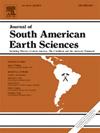Fault-related carbonates as evidence of continentalization during the Permian-Triassic of the Paraná Basin, Southern Brazil
IF 1.7
4区 地球科学
Q3 GEOSCIENCES, MULTIDISCIPLINARY
引用次数: 0
Abstract
Carbonates in fault planes and fractures can serve as a geological record, accurately documenting an area's tectonic and paleoenvironmental evolution. Due to the precipitation as diferent events and under various conditions, these minerals enable the reconstruction of tectonic and hydrogeological conditions that shaped the local geological history. Additionally, compositional and isotopic analyses of these carbonates allow correlations with larger orogenic episodes, situating the local context within a broader regional or global tectonic framework. Therefore, multiple analyses were performed on five distinct carbonates precipitated in a thrust fault and fractures of the Rio do Rasto Formation's sandstones (southern Paraná Basin, Dom Pedrito, Brazil). Based on detailed fieldwork, petrography, X-ray diffraction, geochemical analyses (major, trace, and rare earth elements), and stable isotope, the carbonates were categorized into at least two main precipitation phases. The gouge carbonate, a described type indicates that crushing resulted from fault movement during tectonic reactivations subsequently its initial precipitation. The euhedral calcite crystals in the associated fractures indicate infilling under stable tectonic conditions, suggesting a late-stage cementation phase. These events developed at near-surface temperatures between 28 and 30 °C, influenced by brackish waters, likely from shallow marine environments preceding a continentalization event. The structural features of the outcrop, such as the reverse fault and "S"-shaped folds, suggest an association with compressive events linked to the San Rafael Orogeny, which affected parts of western Argentina and Chile during the Late Paleozoic.
断层相关碳酸盐岩作为巴西南部帕拉纳盆地二叠纪-三叠纪大陆化的证据
断面和裂缝中的碳酸盐岩可以作为地质记录,准确地记录了一个地区的构造和古环境演化。由于不同事件和不同条件下的降水,这些矿物能够重建塑造当地地质历史的构造和水文地质条件。此外,这些碳酸盐的成分和同位素分析可以与更大的造山带相关联,将当地背景置于更广泛的区域或全球构造框架中。因此,对冲断断层和里约热内卢do Rasto组砂岩裂缝中沉积的五种不同的碳酸盐进行了多重分析(巴西帕拉南盆地,Dom Pedrito)。根据详细的野外考察、岩石学、x射线衍射、地球化学分析(主要元素、微量元素和稀土元素)和稳定同位素,将碳酸盐划分为至少两个主要的沉淀阶段。所描述的断层泥碳酸盐岩类型表明,在构造再活化过程中,断层运动导致了初始沉积的破碎。伴生裂缝内的自面体方解石晶体显示在稳定的构造条件下充填,表明胶结期较晚。这些事件发生在近地表温度28至30°C之间,受到可能来自大陆化事件之前的浅海环境的咸淡水的影响。该露头的构造特征,如逆断层和“S”形褶皱,表明其与晚古生代影响阿根廷西部和智利部分地区的圣拉斐尔造山运动有关。
本文章由计算机程序翻译,如有差异,请以英文原文为准。
求助全文
约1分钟内获得全文
求助全文
来源期刊

Journal of South American Earth Sciences
地学-地球科学综合
CiteScore
3.70
自引率
22.20%
发文量
364
审稿时长
6-12 weeks
期刊介绍:
Papers must have a regional appeal and should present work of more than local significance. Research papers dealing with the regional geology of South American cratons and mobile belts, within the following research fields:
-Economic geology, metallogenesis and hydrocarbon genesis and reservoirs.
-Geophysics, geochemistry, volcanology, igneous and metamorphic petrology.
-Tectonics, neo- and seismotectonics and geodynamic modeling.
-Geomorphology, geological hazards, environmental geology, climate change in America and Antarctica, and soil research.
-Stratigraphy, sedimentology, structure and basin evolution.
-Paleontology, paleoecology, paleoclimatology and Quaternary geology.
New developments in already established regional projects and new initiatives dealing with the geology of the continent will be summarized and presented on a regular basis. Short notes, discussions, book reviews and conference and workshop reports will also be included when relevant.
 求助内容:
求助内容: 应助结果提醒方式:
应助结果提醒方式:


